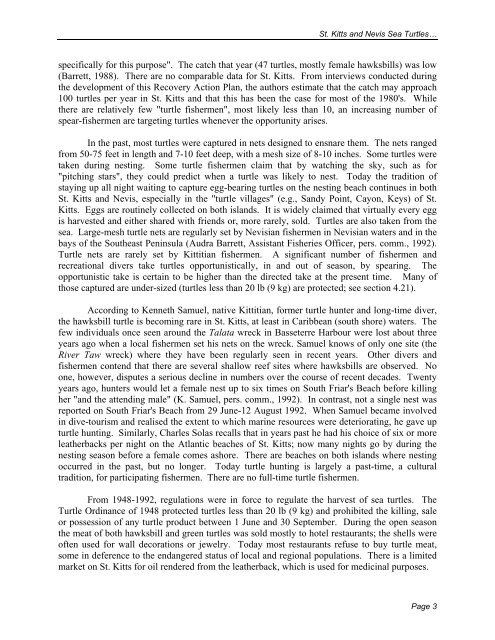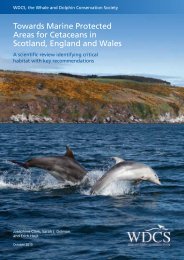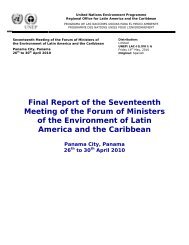Sea Turtle Recovery Action Plan for St. Kitts and Nevis - WIDECAST
Sea Turtle Recovery Action Plan for St. Kitts and Nevis - WIDECAST
Sea Turtle Recovery Action Plan for St. Kitts and Nevis - WIDECAST
Create successful ePaper yourself
Turn your PDF publications into a flip-book with our unique Google optimized e-Paper software.
<strong>St</strong>. <strong>Kitts</strong> <strong>and</strong> <strong>Nevis</strong> <strong>Sea</strong> <strong>Turtle</strong>s…specifically <strong>for</strong> this purpose". The catch that year (47 turtles, mostly female hawksbills) was low(Barrett, 1988). There are no comparable data <strong>for</strong> <strong>St</strong>. <strong>Kitts</strong>. From interviews conducted duringthe development of this <strong>Recovery</strong> <strong>Action</strong> <strong>Plan</strong>, the authors estimate that the catch may approach100 turtles per year in <strong>St</strong>. <strong>Kitts</strong> <strong>and</strong> that this has been the case <strong>for</strong> most of the 1980's. Whilethere are relatively few "turtle fishermen", most likely less than 10, an increasing number ofspear-fishermen are targeting turtles whenever the opportunity arises.In the past, most turtles were captured in nets designed to ensnare them. The nets rangedfrom 50-75 feet in length <strong>and</strong> 7-10 feet deep, with a mesh size of 8-10 inches. Some turtles weretaken during nesting. Some turtle fishermen claim that by watching the sky, such as <strong>for</strong>"pitching stars", they could predict when a turtle was likely to nest. Today the tradition ofstaying up all night waiting to capture egg-bearing turtles on the nesting beach continues in both<strong>St</strong>. <strong>Kitts</strong> <strong>and</strong> <strong>Nevis</strong>, especially in the "turtle villages" (e.g., S<strong>and</strong>y Point, Cayon, Keys) of <strong>St</strong>.<strong>Kitts</strong>. Eggs are routinely collected on both isl<strong>and</strong>s. It is widely claimed that virtually every eggis harvested <strong>and</strong> either shared with friends or, more rarely, sold. <strong>Turtle</strong>s are also taken from thesea. Large-mesh turtle nets are regularly set by <strong>Nevis</strong>ian fishermen in <strong>Nevis</strong>ian waters <strong>and</strong> in thebays of the Southeast Peninsula (Audra Barrett, Assistant Fisheries Officer, pers. comm., 1992).<strong>Turtle</strong> nets are rarely set by Kittitian fishermen. A significant number of fishermen <strong>and</strong>recreational divers take turtles opportunistically, in <strong>and</strong> out of season, by spearing. Theopportunistic take is certain to be higher than the directed take at the present time. Many ofthose captured are under-sized (turtles less than 20 lb (9 kg) are protected; see section 4.21).According to Kenneth Samuel, native Kittitian, <strong>for</strong>mer turtle hunter <strong>and</strong> long-time diver,the hawksbill turtle is becoming rare in <strong>St</strong>. <strong>Kitts</strong>, at least in Caribbean (south shore) waters. Thefew individuals once seen around the Talata wreck in Basseterre Harbour were lost about threeyears ago when a local fishermen set his nets on the wreck. Samuel knows of only one site (theRiver Taw wreck) where they have been regularly seen in recent years. Other divers <strong>and</strong>fishermen contend that there are several shallow reef sites where hawksbills are observed. Noone, however, disputes a serious decline in numbers over the course of recent decades. Twentyyears ago, hunters would let a female nest up to six times on South Friar's Beach be<strong>for</strong>e killingher "<strong>and</strong> the attending male" (K. Samuel, pers. comm., 1992). In contrast, not a single nest wasreported on South Friar's Beach from 29 June-12 August 1992. When Samuel became involvedin dive-tourism <strong>and</strong> realised the extent to which marine resources were deteriorating, he gave upturtle hunting. Similarly, Charles Solas recalls that in years past he had his choice of six or moreleatherbacks per night on the Atlantic beaches of <strong>St</strong>. <strong>Kitts</strong>; now many nights go by during thenesting season be<strong>for</strong>e a female comes ashore. There are beaches on both isl<strong>and</strong>s where nestingoccurred in the past, but no longer. Today turtle hunting is largely a past-time, a culturaltradition, <strong>for</strong> participating fishermen. There are no full-time turtle fishermen.From 1948-1992, regulations were in <strong>for</strong>ce to regulate the harvest of sea turtles. The<strong>Turtle</strong> Ordinance of 1948 protected turtles less than 20 lb (9 kg) <strong>and</strong> prohibited the killing, saleor possession of any turtle product between 1 June <strong>and</strong> 30 September. During the open seasonthe meat of both hawksbill <strong>and</strong> green turtles was sold mostly to hotel restaurants; the shells wereoften used <strong>for</strong> wall decorations or jewelry. Today most restaurants refuse to buy turtle meat,some in deference to the endangered status of local <strong>and</strong> regional populations. There is a limitedmarket on <strong>St</strong>. <strong>Kitts</strong> <strong>for</strong> oil rendered from the leatherback, which is used <strong>for</strong> medicinal purposes.Page 3

















